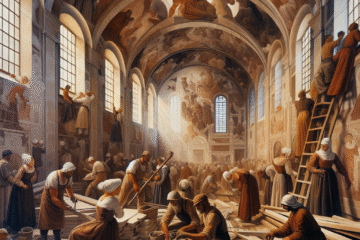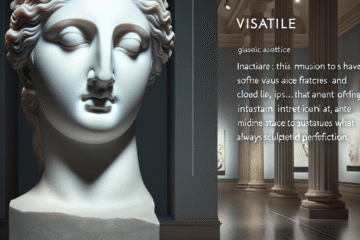I. Introduction
The Symbolism Movement emerged in Europe during the late 19th century as a response to the perceived lack of spirituality and meaning in modern society. Symbolist artists sought to create works that would evoke emotions and ideas through the use of symbols, rather than simply depicting reality as it appeared. Symbolist art often relied on dreamlike or mystical imagery, and frequently explored themes such as spirituality, death, and the subconscious.
Understanding symbolism in art is important because it allows us to appreciate the deeper meanings and messages that artists are trying to convey. By decoding the symbols used in a work of art, we can gain insight into the artist’s worldview, the cultural context in which the work was created, and the ways in which art can communicate complex ideas and emotions.
In this article, we will explore the origins of the Symbolism Movement, the techniques and symbols used in Symbolist art, the importance of interpretation in understanding Symbolist works, the legacy of the movement, and the ways in which Symbolist ideas are still relevant today. Through this exploration, we hope to provide readers with a deeper understanding and appreciation of the Symbolism Movement, and the power of symbolism in art.
II. The Origins of the Symbolism Movement
The Symbolism Movement emerged in Europe in the late 19th century, during a time of great political, social, and cultural change. The Industrial Revolution had transformed the nature of work and society, and many artists and thinkers were struggling to find meaning in this new world. Symbolism was a response to this crisis of meaning, and sought to create works of art that would evoke emotions and ideas beyond what could be conveyed through realistic depictions.
The Symbolism Movement was largely associated with artists and thinkers in France and Belgium, although its influence was felt throughout Europe and beyond. Some of the most famous Symbolist artists include Gustave Moreau, Odilon Redon, and Pierre Puvis de Chavannes. Symbolist writers and thinkers included Charles Baudelaire, Stéphane Mallarmé, and Arthur Rimbaud.
Symbolist artists used a variety of techniques to convey their messages, often relying on richly symbolic imagery that could be interpreted in multiple ways. They frequently used metaphor and allegory to explore themes such as spirituality, death, and the subconscious. Many Symbolist works were highly detailed, with intricate patterns and ornamental elements that contributed to their dreamlike quality.
Symbolist artists were also influenced by the art and mythology of ancient cultures, as well as by the Gothic architecture and art of the Middle Ages. This interest in the past reflected a desire to connect with a sense of history and tradition, as well as a rejection of the technological and scientific progress that had come to dominate modern society.
Overall, the Symbolism Movement was a complex and multifaceted response to the challenges of modernity, seeking to create works of art that would express the deep emotions and spiritual yearnings of the human experience. Its influence can be seen in a wide range of artistic movements that followed, including Surrealism, Expressionism, and Abstract Art.
III. Symbolism in Art
Symbolism in art refers to the use of symbols or symbolic imagery to convey a deeper meaning or message beyond the literal representation. In Symbolist art, symbols are often used to evoke emotions, spiritual concepts, or ideas that cannot be expressed through direct representation.
Symbolist artists used a wide range of symbols, including animals, plants, colors, and objects, each of which carried its own particular significance. Some of the most commonly used symbols in Symbolist art include:
- Flowers: Flowers, such as lilies or roses, were often used to represent emotions or ideas, such as purity, love, or death.
- Animals: Animals, such as snakes, owls, or cats, were often used to represent different aspects of human nature, such as wisdom, mystery, or sensuality.
- Colors: Colors were often used to represent different emotions or concepts, such as red for passion or green for nature.
- Mythological Figures: Mythological figures, such as the Greek goddess Athena or the Egyptian god Osiris, were often used to represent different aspects of the human experience, such as wisdom, death, or the afterlife.
Examples of famous Symbolist paintings include Gustave Moreau’s “The Apparition” and Odilon Redon’s “The Eye Like a Strange Balloon Mounts Toward Infinity”. In “The Apparition,” Moreau uses the figure of Salomé to represent desire and temptation, with her dance and the veil she holds symbolizing the seduction of the senses. The peacock feathers that surround her represent vanity and excess. In “The Eye Like a Strange Balloon Mounts Toward Infinity,” Redon uses the image of an eye to represent the power of the imagination and the limitless possibilities of the mind.
Overall, the symbols used in Symbolist art were highly personal and subjective, with each artist using them to convey their own unique vision of the world. By decoding the symbols used in Symbolist works, we can gain a deeper understanding of the artist’s intent and the underlying meanings and emotions they were trying to convey.
IV. The Importance of Interpretation in Symbolist Art
Symbolist art is characterized by the use of symbols and allegory, which often require interpretation to fully understand their meanings. Interpretation is a crucial component of understanding Symbolist art, as it allows us to delve into the deeper emotions, ideas, and themes that the artist was trying to convey.
Interpretation of Symbolist art can take many different forms, depending on the viewer’s personal experiences and cultural background. Some common approaches to interpreting Symbolist art include:
- Psychological Interpretation: This approach focuses on the psychological and emotional aspects of the symbols used in the artwork, exploring the ways in which they might reflect the artist’s own inner thoughts and feelings.
- Cultural Interpretation: This approach looks at the cultural and historical context in which the artwork was created, examining the ways in which the symbols used in the artwork might reflect broader cultural beliefs or values.
- Formalist Interpretation: This approach focuses on the formal qualities of the artwork, such as its composition, color, and brushwork, exploring the ways in which these elements might contribute to the artwork’s overall meaning.
Examples of Symbolist paintings that can be interpreted in multiple ways include “The Scream” by Edvard Munch and “The Persistence of Memory” by Salvador Dalí. In “The Scream,” the figure’s open mouth can be interpreted as a symbol of anguish, fear, or even ecstasy, depending on the viewer’s interpretation. In “The Persistence of Memory,” the melting clocks can be seen as a symbol of the fluidity of time, the impermanence of life, or the elusive nature of memory.
Overall, interpretation is a crucial component of understanding Symbolist art, as it allows us to delve into the deeper meanings and emotions that are often hidden beneath the surface of the artwork. By exploring different interpretations of Symbolist art, we can gain a deeper appreciation of the complexity and richness of this fascinating artistic movement.
V. The Legacy of the Symbolism Movement
The Symbolism Movement had a profound influence on later art movements, both in Europe and around the world. Symbolist artists paved the way for the development of Surrealism, Expressionism, and other avant-garde movements of the 20th century, which continued to explore the use of symbols and allegory to convey deeper meanings and emotions.
The influence of Symbolism can be seen in the work of many contemporary artists, who continue to explore the use of symbolism and allegory in their own work. Examples of contemporary artists who have been influenced by Symbolism include:
- Kiki Smith: Smith is an American artist known for her use of allegory and mythology in her work. Her sculptures and installations often feature images of the body, animals, and natural elements, which she uses to explore themes such as sexuality, identity, and mortality.
- Anselm Kiefer: Kiefer is a German painter and sculptor known for his monumental works that explore themes of history, mythology, and the human condition. His works often incorporate elements of nature, architecture, and cultural symbolism, which he uses to convey a sense of awe and wonder.
- Marlene Dumas: Dumas is a South African painter known for her emotionally charged portraits that explore themes such as identity, gender, and power. Her works often feature images of the body, which she uses to explore the complexities of human experience.
Symbolist ideas are still relevant today, as artists continue to explore the use of symbols and allegory to convey deeper meanings and emotions. Symbolism continues to be a powerful tool for artists who seek to express the complexity of the human experience, and to evoke emotions and ideas that cannot be expressed through direct representation.
In conclusion, the Symbolism Movement has had a profound impact on the history of art, inspiring generations of artists to explore the use of symbols and allegory to convey deeper meanings and emotions. Its influence can be seen in a wide range of artistic movements that followed, and continues to be felt in the work of contemporary artists today. Symbolism has left an indelible mark on the history of art, and continues to be a powerful and relevant artistic movement.
VI. Conclusion
In this article, we have explored the Symbolism Movement, a fascinating artistic movement that emerged in Europe in the late 19th century. We have discussed the historical context in which the movement emerged, the artists and thinkers who were associated with it, and the techniques and symbols used in Symbolist art. We have also explored the importance of interpretation in understanding Symbolist art, and the ways in which the movement has influenced later art movements and continues to be relevant today.
Symbolism continues to captivate audiences today, with its richly symbolic imagery and mysterious, dreamlike quality. The enduring appeal of Symbolist art lies in its ability to convey complex emotions and ideas in a way that is both subtle and profound, inviting viewers to engage with the artwork on a deeper level.
Understanding Symbolism in art is important because it allows us to appreciate the deeper meanings and messages that artists are trying to convey. By decoding the symbols used in a work of art, we can gain insight into the artist’s worldview, the cultural context in which the work was created, and the ways in which art can communicate complex ideas and emotions. Symbolism challenges us to think deeply about the world around us, and to explore the rich and varied ways in which we experience it.
In conclusion, Symbolism remains a vital and important artistic movement, whose influence continues to be felt today. By understanding Symbolism in art, we can gain a deeper appreciation of the power of art to convey complex emotions and ideas, and to challenge our understanding of the world around us.


